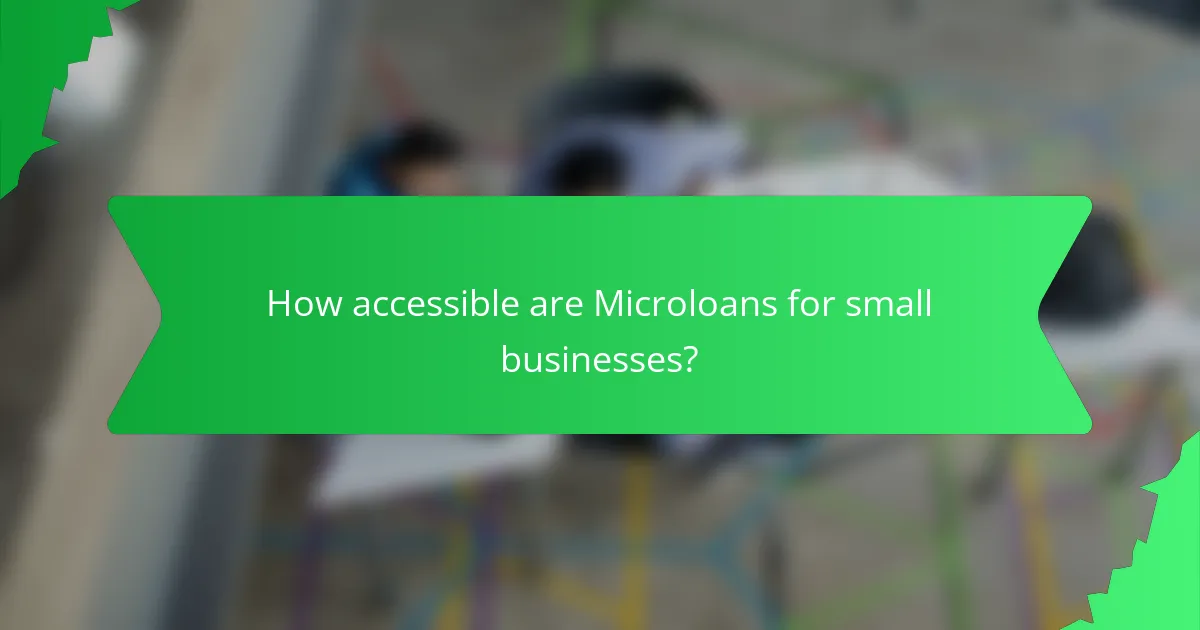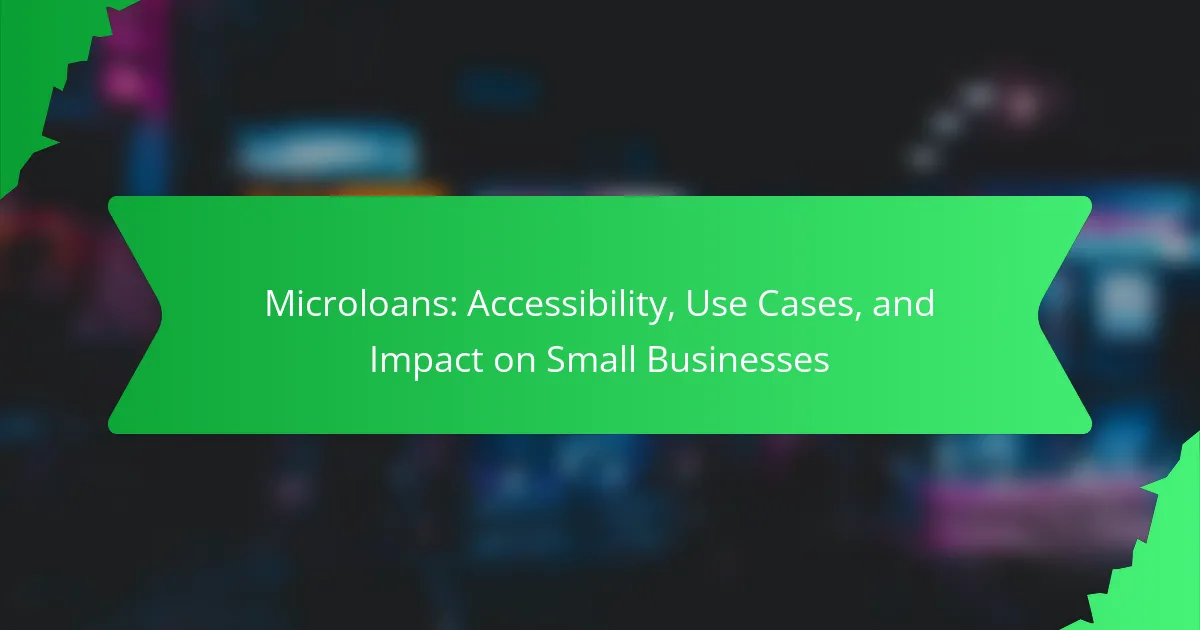Microloans are small loans ranging from $100 to $50,000, aimed at providing financial support to individuals and small businesses lacking access to traditional banking. These loans, often with lower interest rates than payday loans, are primarily utilized for startup capital, operational expenses, and inventory purchases. Organizations like Grameen Bank have pioneered microloans, which have been shown to improve economic conditions for borrowers by increasing household income and business sustainability. With a focus on underserved communities, microloans play a significant role in fostering entrepreneurship and stimulating local economies, empowering millions of small businesses worldwide.

What are Microloans?
Microloans are small loans typically ranging from $100 to $50,000. They are designed to provide financial support to individuals and small businesses that lack access to traditional banking services. Microloans often have lower interest rates compared to payday loans. They are primarily used for starting or expanding small businesses, covering operational costs, or purchasing inventory. Organizations like Grameen Bank pioneered the concept of microloans in the 1980s. Research shows that microloans can significantly improve the economic conditions of borrowers. A study by the Consultative Group to Assist the Poor found that microloans increase household income and business sustainability.
How do Microloans differ from traditional loans?
Microloans differ from traditional loans primarily in their size and accessibility. Microloans are typically smaller amounts, often ranging from $100 to $50,000. Traditional loans usually start at much higher amounts, often exceeding $10,000.
Microloans are designed to support small businesses and entrepreneurs who may not qualify for conventional financing. Traditional loans often require extensive credit history and collateral.
Microloans have more flexible qualification criteria. They may consider the business plan and potential rather than just credit scores. Traditional loans often focus heavily on the borrower’s creditworthiness.
Additionally, microloans often come with lower interest rates and better repayment terms for borrowers. Traditional loans can have higher rates and more rigid repayment schedules.
The purpose of microloans is to foster entrepreneurship and economic development in underserved communities. Traditional loans may not specifically target these groups.
In summary, microloans are smaller, more accessible, and tailored for small businesses, while traditional loans are larger and more stringent in their requirements.
What are the key characteristics of Microloans?
Microloans are small, short-term loans designed to support entrepreneurs and small businesses. They typically range from $100 to $50,000. Microloans often have lower interest rates compared to traditional loans. They are accessible to individuals with limited credit history. The application process is usually less stringent than conventional banking loans. Microloans are often provided by non-profit organizations and community lenders. They are intended to promote economic development and reduce poverty. According to the Microloan Program by the U.S. Small Business Administration, these loans have helped thousands of small businesses start and grow.
Why are Microloans considered a viable option for small businesses?
Microloans are considered a viable option for small businesses due to their accessibility and tailored support. They typically offer lower loan amounts, ranging from $500 to $50,000. This makes them suitable for startups and entrepreneurs with limited capital. Microloans often have less stringent credit requirements compared to traditional loans. This allows individuals with lower credit scores to secure funding. Additionally, microloan programs frequently provide personalized business training and mentorship. These resources enhance the likelihood of business success. According to the U.S. Small Business Administration, microloans have a high repayment rate, averaging around 90%. This indicates their effectiveness in supporting small business growth.
What types of Microloans are available?
There are several types of microloans available. These include individual microloans, which are typically offered to entrepreneurs for personal business needs. Group microloans are provided to a group of borrowers who share responsibility for repayment. Peer-to-peer microloans connect borrowers directly with individual lenders through online platforms. Nonprofit microloans are offered by organizations focused on social impact rather than profit. Lastly, government-backed microloans are provided with support from governmental agencies to encourage small business growth. Each type serves different borrower needs and purposes in the microfinance landscape.
What are the different categories of Microloans?
Microloans can be categorized into several types. The main categories include personal microloans, business microloans, agricultural microloans, and educational microloans. Personal microloans are typically used for individual needs, such as emergency expenses or personal projects. Business microloans are aimed at small entrepreneurs to help start or expand a business. Agricultural microloans are specifically designed for farmers to purchase equipment or seeds. Educational microloans assist students in funding their education. Each category serves distinct purposes and target audiences, reflecting the diverse needs of borrowers.
How do specific Microloan programs cater to diverse business needs?
Specific microloan programs cater to diverse business needs by offering tailored financial solutions. These programs often focus on underserved communities and specific industries. For instance, some microloans are designed for women entrepreneurs, providing them with easier access to funds. Others may target agricultural businesses, offering loans that account for seasonal income fluctuations.
Programs like Kiva allow borrowers to set their own repayment terms, accommodating varying cash flow situations. Additionally, organizations such as Accion provide financial education alongside funding, helping businesses develop sustainable practices.
Research shows that microloans can significantly increase business survival rates. According to a study by the Aspen Institute, businesses that received microloans showed a 50% increase in revenue within the first year. This demonstrates how specific microloan programs effectively meet diverse business needs by offering customized support and financial resources.

How accessible are Microloans for small businesses?
Microloans are generally accessible for small businesses. They are designed to provide financial support to entrepreneurs who may not qualify for traditional loans. Various organizations, including non-profits and community banks, offer microloans. The typical loan amount ranges from $500 to $50,000. Interest rates can vary but often remain lower than those of credit cards. The application process is usually less stringent than for conventional loans. Many microloan programs prioritize underserved communities, enhancing accessibility. According to the Aspen Institute, microloans have helped over 1.5 million small businesses since 1990. This data indicates a significant role in supporting small business growth and sustainability.
What factors influence the accessibility of Microloans?
The accessibility of microloans is influenced by several key factors. These factors include borrower credit history, loan provider policies, and regulatory frameworks. Borrowers with a strong credit history are more likely to secure microloans. Loan providers often have specific criteria that determine eligibility. These criteria can include income level, business plan quality, and collateral availability. Regulatory frameworks also play a significant role in shaping microloan accessibility. For example, government policies can facilitate or restrict lending practices. Access to financial education and support services further impacts borrowers’ ability to obtain microloans. Research indicates that areas with higher financial literacy report better access to microloans.
How do eligibility criteria vary among Microloan providers?
Eligibility criteria vary significantly among microloan providers. Each provider establishes its own set of requirements based on their mission and target audience. Common criteria include credit history, income level, and business plan viability. Some providers focus on underserved communities, while others may prioritize specific industries. For instance, nonprofit microloan organizations often have more flexible criteria compared to traditional financial institutions. Additionally, the loan amount and interest rates can differ based on the provider’s risk assessment. Research indicates that over 70% of microloan providers consider personal character and community ties as essential factors in their eligibility assessments. This variability allows microloan providers to cater to diverse borrower needs and circumstances.
What role do credit scores play in Microloan accessibility?
Credit scores significantly influence microloan accessibility. Lenders use credit scores to assess a borrower’s creditworthiness. A higher credit score typically indicates lower risk for lenders. Consequently, individuals with good credit scores are more likely to receive favorable loan terms. In contrast, those with poor credit scores may face higher interest rates or outright denial. Research shows that lenders often rely on credit scores to make quick decisions on microloan applications. According to a report by the Federal Reserve, credit scores are a key factor in determining loan approval rates for small loans. Thus, credit scores play a crucial role in shaping the accessibility of microloans for borrowers.
What challenges do small businesses face in obtaining Microloans?
Small businesses face several challenges in obtaining microloans. One primary challenge is the stringent eligibility criteria set by lenders. Many small businesses lack established credit histories, making approval difficult. Additionally, small businesses often struggle to provide adequate collateral. This can lead to rejection of loan applications.
Another challenge is the high interest rates associated with microloans. These rates can strain the financial resources of small businesses. Limited awareness of available microloan options also hinders access. Many entrepreneurs do not know where to find these loans or how to apply.
Furthermore, the application process can be lengthy and complex. Small business owners may lack the time or resources to navigate it effectively. According to the Small Business Administration, only a fraction of applicants receive funding. This statistic highlights the competitive nature of microloan acquisition.
How do application processes impact small business owners?
Application processes significantly impact small business owners by determining their access to funding. Lengthy and complex application processes can deter small business owners from seeking financial assistance. Research indicates that 60% of small business owners abandon applications due to excessive documentation requirements. Furthermore, a streamlined application process can enhance approval rates, enabling quicker access to necessary capital. A study by the Small Business Administration found that businesses with simplified applications are 40% more likely to secure loans. Ultimately, the efficiency of application processes directly influences the financial health and growth potential of small businesses.
What are common misconceptions about Microloan accessibility?
Common misconceptions about microloan accessibility include the belief that they are only available to low-income individuals. In reality, microloans can be accessed by a wide range of entrepreneurs, regardless of income level. Another misconception is that microloans require excellent credit scores. Many microfinance institutions focus more on the business plan and potential for success rather than credit history.
Some people think that microloans are only for specific industries. However, these loans can support various sectors, including agriculture, retail, and services. Additionally, there is a belief that microloans are not enough to make a significant impact. Studies show that even small amounts, such as $500 to $5,000, can help businesses grow and create jobs.
Lastly, many assume that the application process is overly complicated. In fact, many microfinance organizations have streamlined their processes to make them more accessible to entrepreneurs.

What are the use cases of Microloans for small businesses?
Microloans for small businesses are primarily used for startup capital, inventory purchases, and operational expenses. They help entrepreneurs access funding when traditional loans are unavailable. Small businesses often use microloans to finance equipment purchases, which can enhance productivity. Additionally, businesses utilize microloans for marketing efforts to increase visibility and sales. These loans also support working capital needs, ensuring smooth daily operations. According to the Microfinance Gateway, microloans have empowered over 140 million clients worldwide, illustrating their significant impact on small business growth.
How can small businesses effectively utilize Microloans?
Small businesses can effectively utilize microloans by identifying specific needs for funding. They should create a detailed business plan outlining how the funds will be used. This plan should include projected financial outcomes. Small businesses can apply for microloans through community lenders or online platforms. They should ensure they meet eligibility criteria, such as credit score and business history. Once secured, businesses must use the funds wisely, focusing on growth opportunities. According to the Small Business Administration, microloans can range from $500 to $50,000, providing essential capital for startups and expansions. Proper utilization of microloans can lead to increased cash flow and business sustainability.
What are the most common purposes for which Microloans are used?
Microloans are commonly used for various purposes, primarily to support small business development. Entrepreneurs often utilize microloans to purchase inventory, equipment, or supplies. These loans can also help cover operational costs, such as rent and utilities. Many individuals use microloans to start or expand their businesses. Additionally, microloans may assist in funding educational expenses or vocational training for entrepreneurs. According to the Microfinance Gateway, over 80% of microloan recipients use the funds for business-related activities. This statistic highlights the significant role microloans play in fostering entrepreneurship and economic growth.
How do Microloans support business growth and development?
Microloans support business growth and development by providing accessible funding for small enterprises. They often fill the gap where traditional financing options are unavailable. Microloans typically have lower interest rates compared to alternative lending sources. This financial support enables businesses to invest in inventory, equipment, or marketing. Additionally, microloans can help entrepreneurs build credit history. A study by the Aspen Institute found that microloans lead to increased sales and job creation in small businesses. These loans empower underserved communities, fostering economic development and resilience.
What industries benefit most from Microloans?
The industries that benefit most from microloans include agriculture, retail, and services. Agriculture often requires small-scale funding for equipment or seeds. Retail businesses use microloans for inventory purchases and store improvements. Service-oriented industries, such as beauty salons and repair shops, utilize funds for equipment and marketing. According to the Microfinance Gateway, 60% of microloan recipients are in the retail and service sectors. These industries typically have lower barriers to entry, making them ideal candidates for microfinance solutions.
Which sectors see the highest success rates with Microloans?
The sectors that see the highest success rates with microloans include agriculture, retail, and services. Agriculture often benefits from microloans due to the need for small-scale farming equipment and supplies. Retail businesses leverage microloans to stock inventory and enhance their operations. Service-oriented sectors, such as personal services or hospitality, utilize microloans for startup costs and business expansion. According to the Microfinance Gateway, businesses in these sectors report repayment rates exceeding 95%. This data underscores the effectiveness of microloans in fostering growth and sustainability in these industries.
How do Microloans foster innovation in various industries?
Microloans foster innovation in various industries by providing accessible funding to entrepreneurs. This financial support enables small businesses to develop new products and services. Microloans often target underserved populations, encouraging diverse ideas and solutions. For example, in technology, microloans allow startups to invest in research and development. In agriculture, they enable farmers to adopt innovative practices and technologies. According to the World Bank, microfinance can increase business sustainability by 50%. This funding model promotes creativity and adaptability, essential for industry advancement.

What impact do Microloans have on small businesses?
Microloans significantly impact small businesses by providing accessible funding for growth and operations. They enable entrepreneurs to start or expand their ventures with relatively small amounts of capital. Microloans typically range from $500 to $50,000, making them suitable for businesses that may not qualify for traditional loans. Research shows that businesses receiving microloans often experience increased revenue and job creation. A study by the Aspen Institute found that microloans led to a 40% increase in business income for recipients. Additionally, microloans foster financial inclusion by supporting underserved communities. This access to capital helps stimulate local economies and encourages entrepreneurship.
How do Microloans contribute to the sustainability of small businesses?
Microloans contribute to the sustainability of small businesses by providing essential funding for growth and operational needs. They offer access to capital for entrepreneurs who may lack traditional financing options. This financial support enables small businesses to invest in inventory, equipment, and marketing. Microloans typically have lower interest rates and flexible repayment terms compared to conventional loans. These features reduce the financial burden on small business owners. According to the Microfinance Gateway, microloans can increase business revenue by up to 30% within the first year. This boost in revenue enhances the overall economic stability of small businesses. Consequently, microloans play a crucial role in fostering entrepreneurship and creating jobs in local communities.
What are the long-term benefits of Microloans for business owners?
Microloans provide significant long-term benefits for business owners. They enhance access to capital, enabling entrepreneurs to start or expand their businesses. This increased funding can lead to higher revenue growth over time. Microloans often come with lower interest rates compared to traditional loans. This affordability allows business owners to invest more in their operations. Additionally, microloans can improve credit scores as borrowers consistently repay their loans. A stronger credit profile can lead to better loan terms in the future. Furthermore, microloans often foster community development by supporting local businesses. This, in turn, can create jobs and stimulate economic growth in the area.
How do Microloans influence job creation in local communities?
Microloans significantly influence job creation in local communities by providing small businesses with essential funding. These loans enable entrepreneurs to start or expand their businesses, which directly leads to new job opportunities. According to a study by the Consultative Group to Assist the Poor, microloans have been linked to the creation of over 100 million jobs globally since the 1990s. Additionally, local businesses often hire from within their communities, thus reducing unemployment rates. The availability of microloans encourages economic activity, fostering a cycle of growth and job creation.
What are the success stories associated with Microloans?
Microloans have facilitated numerous success stories globally. In Bangladesh, Grameen Bank’s microloan program has empowered millions of women to start small businesses. For instance, one woman used a $50 loan to launch a sewing business, which later expanded to employ several local women. In the Philippines, a microloan initiative helped a farmer purchase seeds and equipment. This investment increased his yield, significantly boosting his family’s income. In Kenya, microloans have supported entrepreneurs in the tech sector. A notable case involved a woman who developed a mobile payment service, now serving thousands. These examples illustrate the transformative impact of microloans on individual livelihoods and community development.
How have Microloans transformed specific small businesses?
Microloans have significantly transformed specific small businesses by providing accessible funding options. Many small businesses previously lacked access to traditional financing. Microloans fill this gap, allowing entrepreneurs to start or expand their ventures. For example, a study by the Aspen Institute found that microloans increased business revenue by an average of 30% within the first year. Additionally, microloans often come with lower interest rates compared to conventional loans. This affordability enables small business owners to reinvest profits back into their operations. Furthermore, microloans promote financial literacy among borrowers, enhancing their overall business acumen. As a result, businesses that utilize microloans often experience improved sustainability and growth.
What lessons can be learned from successful Microloan recipients?
Successful microloan recipients demonstrate key lessons in entrepreneurship. They emphasize the importance of thorough business planning. A solid plan increases the likelihood of loan approval and business success. Additionally, they showcase effective resource management. Successful recipients often leverage their loans for essential business needs, maximizing impact. They also highlight the significance of community support. Networking and mentorship play crucial roles in their growth. Furthermore, adaptability is vital. Many successful recipients adjust their strategies based on market feedback. Lastly, tracking financial performance is essential. Monitoring cash flow helps ensure sustainability and growth. These lessons underscore the potential of microloans in fostering small business success.
What best practices should small businesses follow when seeking Microloans?
Small businesses should prepare a comprehensive business plan when seeking microloans. A well-structured plan outlines the business model, target market, and financial projections. This clarity helps lenders assess the viability of the business. Additionally, businesses should maintain a good credit score. A higher credit score increases the chances of loan approval.
Gathering all necessary documentation is crucial. This includes tax returns, bank statements, and financial statements. Lenders require this information to evaluate the financial health of the business. Businesses should also research different microloan programs. Each program has unique terms and eligibility criteria.
Networking with local organizations can provide valuable insights. These organizations often have resources to assist with the application process. Finally, businesses should be transparent about their funding needs. Clearly communicating the purpose of the loan builds trust with lenders.
Microloans are small loans ranging from $100 to $50,000, designed to provide financial support to individuals and small businesses lacking access to traditional banking services. This article explores the characteristics, types, and accessibility of microloans, highlighting their differences from traditional loans and the challenges small businesses face in obtaining them. It also examines the various use cases of microloans, their impact on business growth and job creation, and success stories that illustrate their transformative potential. The article emphasizes the importance of tailored microloan programs in fostering entrepreneurship and economic development within underserved communities.
